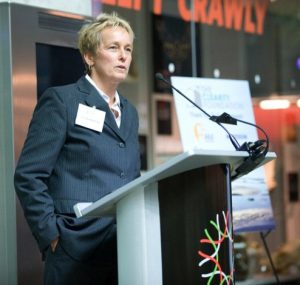The Scientist Becomes the Survivor and Advocate
Laura K. Shawver, PhD, is no stranger to biomedical research and cancer science in particular. She received her doctorate in pharmacology from the University of Iowa and did postdoctoral training at the University of Virginia Cancer Center and Washington University in St. Louis. Following her time in academia, Shawver decided to enter the pharmaceutical world, where she has made important contributions to the development of novel cancer therapeutics, including the receptor tyrosine kinase inhibitor sunitinib (Sutent), currently marketed by Pfizer to treat kidney and stomach cancer.
Shawver quickly earned a reputation as a leader in the pharmaceutical and biotechnology industries. Prior to her current position as chief executive officer of Cleave Biosciences, she served as president of SUGEN, Inc. and chief executive officer of Phenomix Corporation. But along that journey, she encountered a life-changing stumbling block: an ovarian cancer diagnosis.
“Being diagnosed with ovarian cancer changed the way that I think about cancer research and drug development,” recalls Shawver. “Being a cancer drug developer provided me the knowledge that I faced an uphill battle with my diagnosis, the feeling of desperation because I knew the odds were against me.” To face this challenge, she remembers, “I had to have the right team around me.”
After her diagnosis, she realized that this was an opportunity for her to forge a new approach to overcoming ovarian cancer. Indeed, her extensive experience as a cancer researcher and pharmaceutical leader, coupled with her now very personal experience with cancer, motivated Shawver to take this opportunity head on. In 2008, she launched The Clearity Foundation, a nonprofit organization focused on bringing molecular profiling to the forefront of ovarian cancer diagnosis and treatment to help women live longer, healthier lives.
“One of the reasons that I founded Clearity Foundation,” says Shawver, “was because I felt that we could be an important part of the team for other women – especially women whose cancer recurred following standard-of-care chemotherapy or when their treatment failed.”
Treatment failure is a common problem among ovarian cancer patients. Shawver states that “the approved drugs for recurrent ovarian cancer rarely work in more than 20 percent of patients.” That is a four in five chance that patients with recurrent ovarian cancer will receive toxicity without benefit, a startling statistic. “There are several drugs approved for recurrent ovarian cancer and multiple drugs in clinical trials,” she says, “but we need to find a way to prioritize these based on the potential for efficacy rather than pick out of the hat.”
This is one of the main tenets of Clearity’s mission, to move the field of personalized medicine forward for ovarian cancer patients by providing access to molecular profiling and diagnostic tests that can better inform their treatment plan. Shawver hopes that this will eliminate a major barrier to treatment. “Physicians often go through all the FDA-approved drugs and only then do they think about a clinical trial or using a drug off-label,” she says. “After failing four to five different drugs,” Shawver adds, “the tumors become so heterogeneous that the likelihood of a significant effect of a clinical trial agent or off-label drug is low. We need to shift the paradigm and think about clinical trials in first or second relapse as well as bring the insurance companies on board so that they will pay for off-label agents that are appropriate based on molecular alterations that provide a therapeutic rationale.”
Clearity has provided molecular profiling, or “tumor blueprints,” for hundreds of women since its inception. These blueprints are continually added to a database that could uncover correlations between specific tumor blueprints and treatment outcomes, with the goal of providing even more precise information that can be used to guide treatment decisions. “The challenge,” says Shawver, “is to convince more companies to conduct more clinical trials in ovarian cancer and in the subsets of patients that have the best chance to benefit. All women with recurrent ovarian cancer should sign up for a trial that makes sense for them based on their tumor profile.”
Regarding the issue of clinical trials for ovarian cancer, Shawver advocates for a shift in approach. “The traditional approach of having several sites participate in the trial will take too long to enroll because there are so few of us, so we need to figure out how to bring the trial to the patient rather than the patient to the trial,” she says. “This is true for any rare cancer like ovarian cancer that has significant histological and molecular heterogeneity.”
In addition to her work with the Clearity Foundation, Shawver remains a leader in the biotechnology industry. At Cleave Biosciences, she continues to pave the way for the development of novel, effective cancer therapeutics, but with a new perspective. “For me, my cancer diagnosis led me to think differently about how to attack cancer from a non-oncogene addiction standpoint since many ovarian tumors do not have an oncogenic driver mutation,” she says. This is what led her to Cleave, whose focus is on targeting protein homeostasis and understanding pathway addiction. “We now have a drug that targets p97 (an enzyme responsible for destroying misfolded proteins in the cell) in two phase I clinical trials, one in solid tumors,” says Shawver. “It will come as no surprise that we spent considerable time and effort preclinically to understand the molecular determinants of sensitivity and resistance. This is an important part of our clinical strategy.”
When contemplating the future of ovarian cancer diagnosis and treatment, Shawver exudes an air of both determination and optimism. “While we have a number of uphill battles in the quest for a better treatment paradigm, one of our messages to women battling ovarian cancer is that tremendous progress is made every year and that by staying ‘in the fight’ even for six months, new treatment options may become available.”
“A recent example of this,” Shawver recalls, “was a woman with a BRCA-mutated tumor who was being treated for a second recurrence last year but she was not eligible for any of the clinical trials with the PARP inhibitors (drugs that prevent the repair of DNA damage and lead to tumor cell death). She had a third recurrence in January 2015 but because BRCA-targeting agent olaparib (Lynparza) was approved in December 2014, she was able to now have the ‘matched’ treatment. While PARP inhibitors do not work for everyone, she is back in remission with a good quality of life.”
Shawver hopes to be able to share more stories like this, and believes that improvements in outcome can be made, but she stresses that increased research and clinical trials are needed. “I have been a proud AACR member since 1992 so I have watched at conferences over the years the progress of many drugs that have had tremendous benefit for cancer patients. Unfortunately, this has been limited in ovarian cancer,” she says. However, as a member of the Stand Up To Cancer Scientific Advisory Committee, as well as the Joint Scientific Advisory Committee that selected the new SU2C-Ovarian Cancer Research Fund-Ovarian Cancer National Alliance-National Ovarian Cancer Coalition Dream Team, Shawver sees promising new opportunities for progress.
“I was so thrilled to participate in the selection of the Stand Up To Cancer Ovarian Cancer Dream Team and I know this will direct the field to an understanding of PARP inhibitors for a broader range of women as well as to understand how to combine the PARP inhibitors for more effective treatment,” she says.




